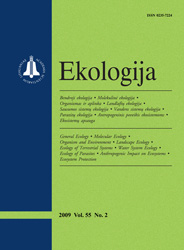 ISSN 0235-7224 ISSN 2029-0586 (online) |
2008 m. Nr. 4 Carbon pool and sequestration in former arable Chernozems depending on restoration period
Abandonment of cultivated lands leads to vegetation succession, restoring of soils, and is accompanied by changes in organic carbon pools and microbial community. This study was aimed to quantify the different carbon organic pools (total, labile, recalcitrant, and microbial) in former croplands depending on the period of abandonment (restoration). Our investigations were carried out in 2007 on arable soil under winter wheat and on soils abandoned for 5, 11, 21 and 77 years after land use change from crops to permanent grassland (Haplic Chernozems, Rostov region, Russia, 47°27’N, 39°35’E). Soil organic carbon (SOC) and microbial carbon (Cmic) increased proportionately to the duration of soil restoration. The average Cmic / SOC ratio was 1.3. The total CO2–C release during 10 weeks of incubation was the highest in arable soil and soil after 5 years of restoration. The abandonment of cultivated soils resulted in an increase of recalcitrant SOC pool: 20.6 mg C g–1 in arable soil vs. 28.6 mg C/g in 77-yr grassland. The mean residence time of recalcitrant C in soils after 11–77 years of restoration was 1.9–2.2 times longer than that in arable soil. Labile C decreased from 0.25 mg C g–1 in arable soil to 0.12 mg C g–1 in soil after 77 years of restoration. Therefore, carbon accumulation in soils after land use change from arable to permanent grassland was mainly caused by sequestration of the recalcitrant C pool. Keywords: land use change, abandonment, set-aside, Chernozems, carbon accumulation, microbial biomass, labile, recalcitrant and total pools of organic carbon, mean residence time of C |
Issues:
2011 - Vol.57 No. 1, No. 2 2010 - Vol.56 No. 1-2, No. 3-4 2009 - Vol.55 No. 1, No. 2, No. 3-4 2008 - Vol.54 No. 1, No. 2, No. 3, No. 4 2007 - Vol.53 No. 1, No. 2, No. 2.priedas, No. 3, No. 4 2006 No. 1, No. 2, No. 3, No. 4 2005 No. 1, No. 2, No. 3, No. 4 2004 No. 1, No. 2, No. 3, No. 4 2003 No. 1, No. 2, No. 3, No. 4 2002 No. 1, No. 2, No. 3, No. 4 2001 No. 1, No. 2, No. 3, No. 4 |